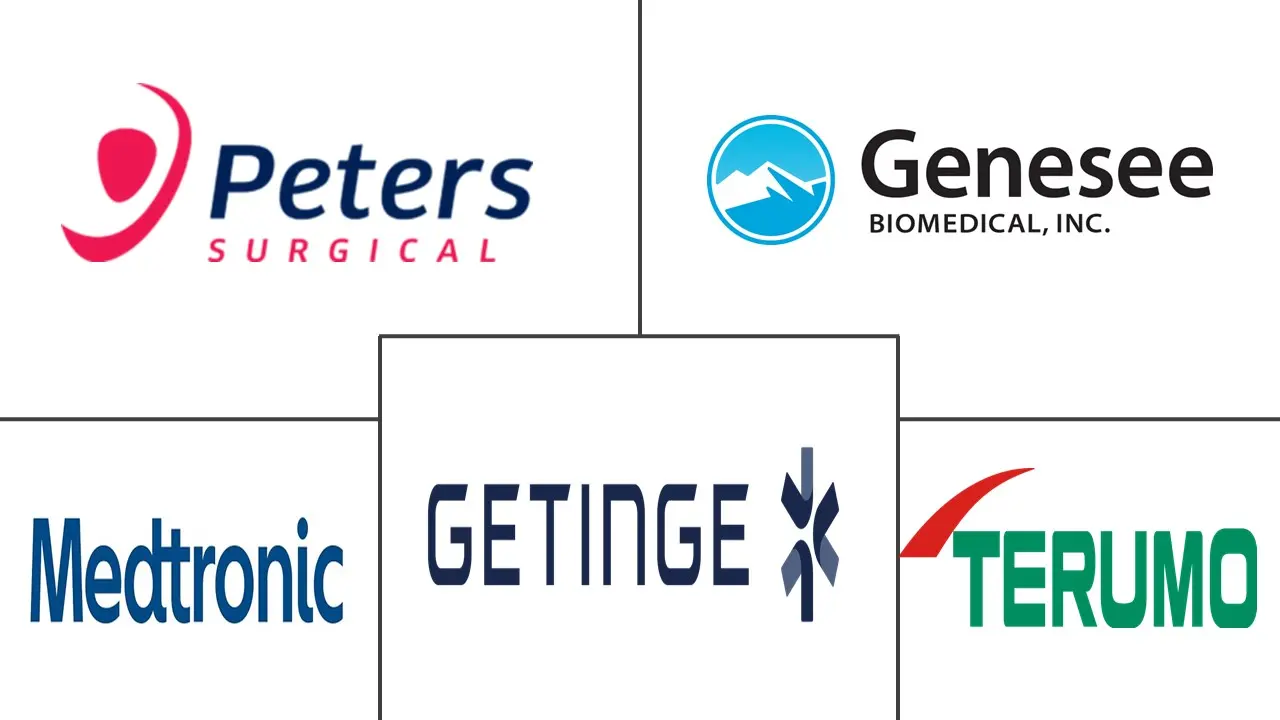Coronary Artery Bypass Grafting Market Size and Share
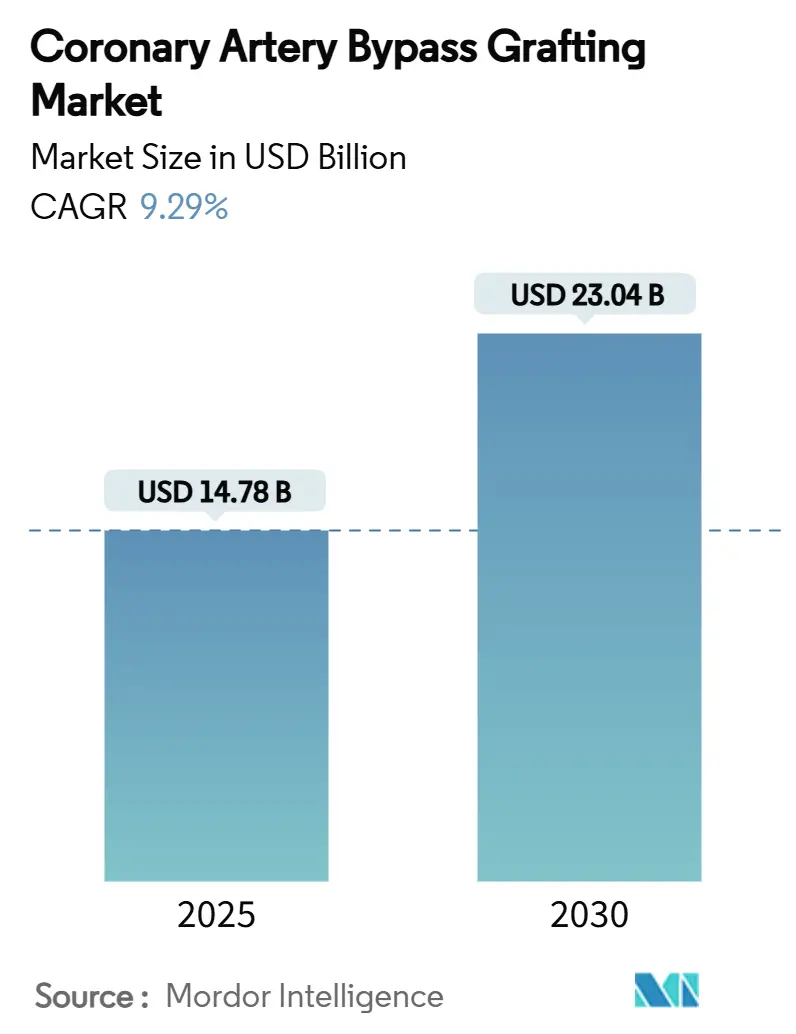
Coronary Artery Bypass Grafting Market Analysis by Mordor Intelligence
The global coronary artery bypass grafting market is valued at USD 14.78 billion in 2025 and is projected to reach USD 23.04 billion by 2030, advancing at a 9.29% CAGR during the forecast period. Steady momentum comes from widening coronary artery disease incidence in aging populations, rapid adoption of hybrid revascularization strategies, and routine use of AI-guided robotic systems that shorten procedure time while improving graft accuracy.[1]Stanford Medicine, “Robotic Hybrid Coronary Revascularization,” med.stanford.edu Growing preference for minimally invasive approaches encourages hospitals to invest in next-generation visualization tools, while demographic expansion in middle-income economies opens new patient pools for advanced cardiac surgery. At the same time, favorable reimbursement pilots in North America and Europe offset capital cost pressures, ensuring continued device upgrades and procedure volume growth.[2]Centers for Medicare & Medicaid Services, “CY 2025 Physician Fee Schedule Final Rule,” cms.gov Competitive rivalry intensifies as incumbents acquire vascular intervention assets, while innovators bring tissue-engineered grafts and predictive analytics to market.
Key Report Takeaways
- By technology, on-pump surgery led with 61.33% of the coronary artery bypass grafting market share in 2024, while hybrid revascularization is forecast to post a 12.73% CAGR to 2030.
- By product group, conduits and grafts accounted for 36.59% of 2024 revenue, whereas synthetic and drug-eluting grafts are set to expand at a 13.43% CAGR through 2030.
- By end-user, tertiary-care hospitals held 68.14% of 2024 demand; ambulatory surgical centers are rising fastest with an 11.15% CAGR.
- By region, North America dominated with 33.77% revenue in 2024, while Asia-Pacific is projected to grow at 12.20% CAGR to 2030.
Global Coronary Artery Bypass Grafting Market Trends and Insights
Drivers Impact Analysis
| Driver | (~) % Impact on CAGR Forecast | Geographic Relevance | Impact Timeline |
|---|---|---|---|
| Rising Prevalence of CAD & Stroke | +2.1% | Global, with concentration in North America & Europe | Long term (≥ 4 years) |
| Technological Advances in Grafts & Robotics | +1.8% | North America & EU leading, APAC adoption accelerating | Medium term (2-4 years) |
| Favourable Reimbursement in Key Markets | +1.3% | North America & Europe primary, selective APAC markets | Short term (≤ 2 years) |
| Hybrid Revascularisation Programmes in ASCs | +1.0% | North America leading, EU selective adoption | Medium term (2-4 years) |
| AI-Guided Intra-Operative Imaging Adoption | +0.9% | Global, concentrated in advanced healthcare systems | Medium term (2-4 years) |
| Donor-Funded Cardiac Surgery Training in LMICs | +0.7% | APAC, MEA, Latin America focus | Long term (≥ 4 years) |
| Source: Mordor Intelligence | |||
Rising Prevalence of CAD & Stroke
Global cardiovascular burden rises as lifestyle risk factors and population aging converge, driving continuous demand for surgical revascularization. The number of Americans living with coronary artery disease is expected to reach 8.5 million by 2030, reinforcing procedure pipelines in high-volume centers.[3]Jian Zhang, “Epidemiology and Burden of Heart Failure in Asia,” JACC: Asia, jacc.orgAsia-Pacific registers earlier onset of multivessel disease, making bypass surgery preferable to complex PCI in many younger patients. A higher incidence of diffuse lesions and smaller vessel diameters further tilts therapy choice toward complete surgical revascularization. This patient mix pushes hospitals to retain robust CABG capacity even as catheter-based solutions expand.
Technological Advances in Grafts & Robotics
Robotic platforms such as the da Vinci system show 30-day mortality near 1.2% and sternotomy conversion below 5%, confirming safety in minimally invasive coronary procedures. Artificial intelligence enhances coronary mapping and intra-operative navigation, supporting surgeons during complex off-pump harvests. Tissue-engineered conduits move toward commercial reality, with Humacyte planning first-in-human trials of acellular small-diameter grafts for CABG in 2025. Together, these innovations widen the addressable patient base by lowering morbidity and shortening hospital stays.
Favourable Reimbursement in Key Markets
The 2025 Medicare Physician Fee Schedule adds billing codes for AI-based cardiovascular risk management, streamlining patient identification and pre-operative work-ups. Episode-based payment pilots starting 2026 reward high-quality outcomes and efficient length of stay, helping providers justify capital investment in robotic suites. This policy landscape encourages device makers to bundle grafts, instruments, and imaging software into cost-effective packages.
Hybrid Revascularization Programmes in ASCs
Ambulatory centers increasingly host combined minimally invasive LIMA-to-LAD grafting with PCI for remaining vessels, cutting inpatient stay to 3-4 days while matching conventional CABG outcomes. The 2024 expansion of ASC-only C-codes for coronary diagnostics and intervention builds strong financial rationale for outpatient programs. Advanced hemostasis tools and fast-track anesthesia protocols reduce post-procedure observation time, freeing ICU beds in tertiary centers. As more payers reimburse same-day discharge, hospitals form joint ventures with ASCs to retain procedure volumes.
Restraints Impact Analysis
| Restraint | (~) % Impact on CAGR Forecast | Geographic Relevance | Impact Timeline |
|---|---|---|---|
| Shift Toward PCI & TAVI | -1.4% | Global, particularly in intermediate-risk populations | Medium term (2-4 years) |
| High Capex & Procedural Cost | -1.1% | Cost-sensitive markets, emerging economies | Long term (≥ 4 years) |
| Tissue-Sourcing Regulatory Disruptions | -0.8% | Global, with regional variation in compliance | Short term (≤ 2 years) |
| Post-Covid Scheduling Bias To PCI | -0.6% | Global, concentrated in systems with resource constraints | Short term (≤ 2 years) |
| Source: Mordor Intelligence | |||
Shift Toward PCI & TAVI
Recent trials show competitive outcomes for PCI in selected left main disease, and transcatheter aortic valve replacement combined with PCI offers a fully catheter-based alternative for dual pathology patients. Yet long-term registries still favor CABG for complex multivessel disease, diabetes, and impaired ventricular function because of lower repeat revascularization and infarction rates. As device iterations improve stent deliverability and durability, interventional cardiology will continue drawing cases from surgical suites, particularly where comorbidity risk is moderate.
High Capex & Procedural Cost
Robotic consoles, hybrid operating rooms, and perfusion systems demand large capital budgets that many public hospitals in emerging economies cannot absorb. Single-use consumables add to procedure cost, limiting adoption where reimbursement does not keep pace with inflation. Provider consolidation partly mitigates budget strain, but return-on-investment depends on stable high procedure volumes, creating access disparities across regions.
Segment Analysis
By Technology: Hybrid Adoption Rises with Robotic Precision
On-pump surgery generated the highest revenue in 2024, reflecting 61.33% of the coronary artery bypass grafting market. Reliable cardiopulmonary bypass techniques and surgeon familiarity keep demand steady in complex anatomies and redo cases. Nevertheless, hybrid techniques led technology growth at 12.73% CAGR as hospitals combine minimally invasive grafting with PCI to balance durability and recovery speed. The coronary artery bypass grafting market size for hybrid procedures is projected to climb sharply through 2030 as evidence shows comparable freedom from major adverse events over a decade.
Robot-assisted harvest enables bilateral internal mammary artery use through a single port, improving long-term patency without widening the incision. Off-pump surgery remains valuable in high-risk patients with calcified aortas where bypass manipulation elevates stroke risk. Taken together, these options allow surgeons to tailor therapy to anatomy, comorbidity, and institutional resources, enhancing procedural outcomes while sustaining overall coronary artery bypass grafting market growth.
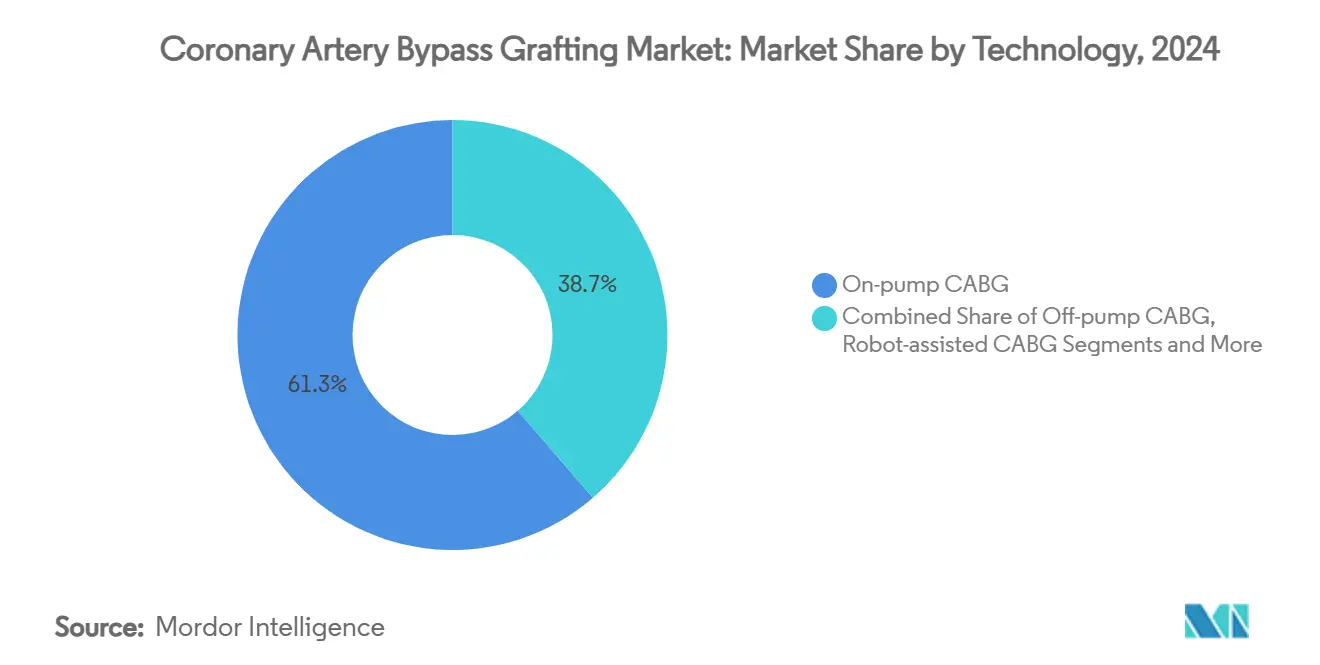
Note: Segment shares of all individual segments available upon report purchase
By Product & Service: Bio-Engineered Grafts Gain Traction
Conduits and grafts retained 36.59% share in 2024, underscoring their foundational role in complete revascularization. Synthetic and drug-eluting alternatives are forecast to record a 13.43% CAGR owing to consistent quality, reduced harvest morbidity, and prospects for off-the-shelf availability. The coronary artery bypass grafting market size for tissue-engineered conduits could expand further once first-in-human data validate durability beyond five years.
Adjunct devices such as retractors, stabilizers, and heart-lung machines advance in step with procedural complexity, while AI-enabled monitoring systems report 22 physiological variables in real time to guide perfusionists. Service offerings branded as CABG Centers of Excellence leverage multidisciplinary teams and outcome analytics, anchoring vendor partnerships that bundle devices, training, and data services. This integrated approach secures recurring revenue streams and fosters stickiness in the coronary artery bypass grafting market.
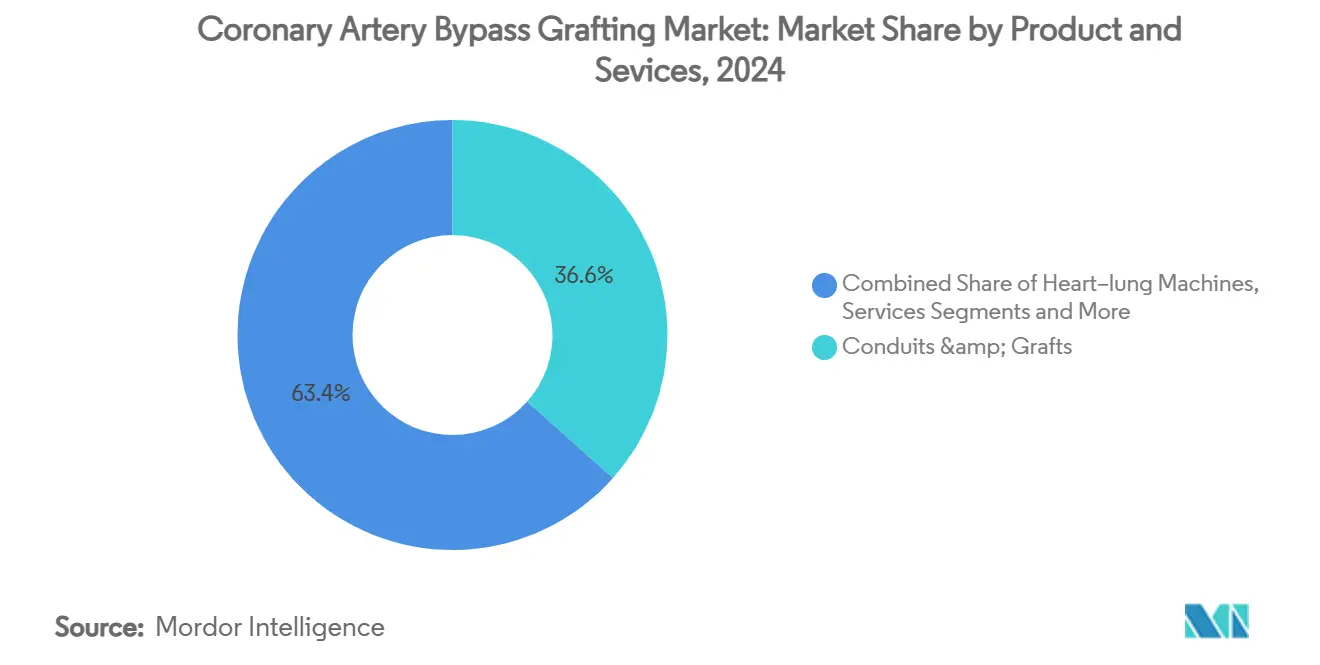
Note: Segment shares of all individual segments available upon report purchase
By End-user: Outpatient Settings Emerge as Growth Catalyst
Tertiary hospitals commanded 68.14% of procedures in 2024 thanks to full ICU backup and high surgeon density, but ambulatory surgical centers are projected to grow at 11.15% CAGR to 2030. The coronary artery bypass grafting market now benefits from payer policy that reimburses hybrid revascularization in ASC settings, encouraging health systems to spin off cardiac specialty centers.
Early outcome analyses show lower post-discharge myocardial infarction rates in ASC patients than hospital outpatient cohorts, confirming appropriate case selection and robust peri-operative protocols. High-acuity cases will remain hospital based, yet the combined model where routine components take place in ASCs and backups sit at neighboring hospitals delivers notable cost savings and convenient scheduling, promoting wider adoption across the coronary artery bypass grafting market.
Geography Analysis
North America held 33.77% of global revenue in 2024, supported by technology leadership, established cardiac surgery programs, and bundled payment pilots that reward quality outcomes. Early uptake of robotic systems and AI-guided imaging reinforces procedure efficiency, while strong capital budgets sustain rapid refresh cycles. Medicare coding changes that pay for AI risk profiling tools further encourage procedure funnel growth, keeping the coronary artery bypass grafting market dynamic across the United States and Canada.
Europe shows steady expansion despite Medical Device Regulation compliance challenges that lengthen approval timelines for novel robotic components. Cross-border training networks and government cardiac centers upgrade perfusion equipment and mapping software to maintain clinical parity with North American peers. Scandinavian countries pilot value-based procurement contracts that bundle grafts, disposables, and service agreements, protecting margins while securing supply chain stability.
Asia-Pacific is forecast to post the fastest 12.20% CAGR through 2030 as rising disposable income and donor-funded surgical training programs broaden access to advanced revascularization. India attracts international patients with procedure costs 50-80% lower than Western averages, supporting medical tourism growth inside the coronary artery bypass grafting market. China partners with neighboring Cambodia to screen millions for congenital heart disease, highlighting regional commitment to cardiovascular care. Middle East and Africa plus South America continue upgrading centers with international assistance, though capital investment limitations and supply chain delays moderate near-term procedure volumes.
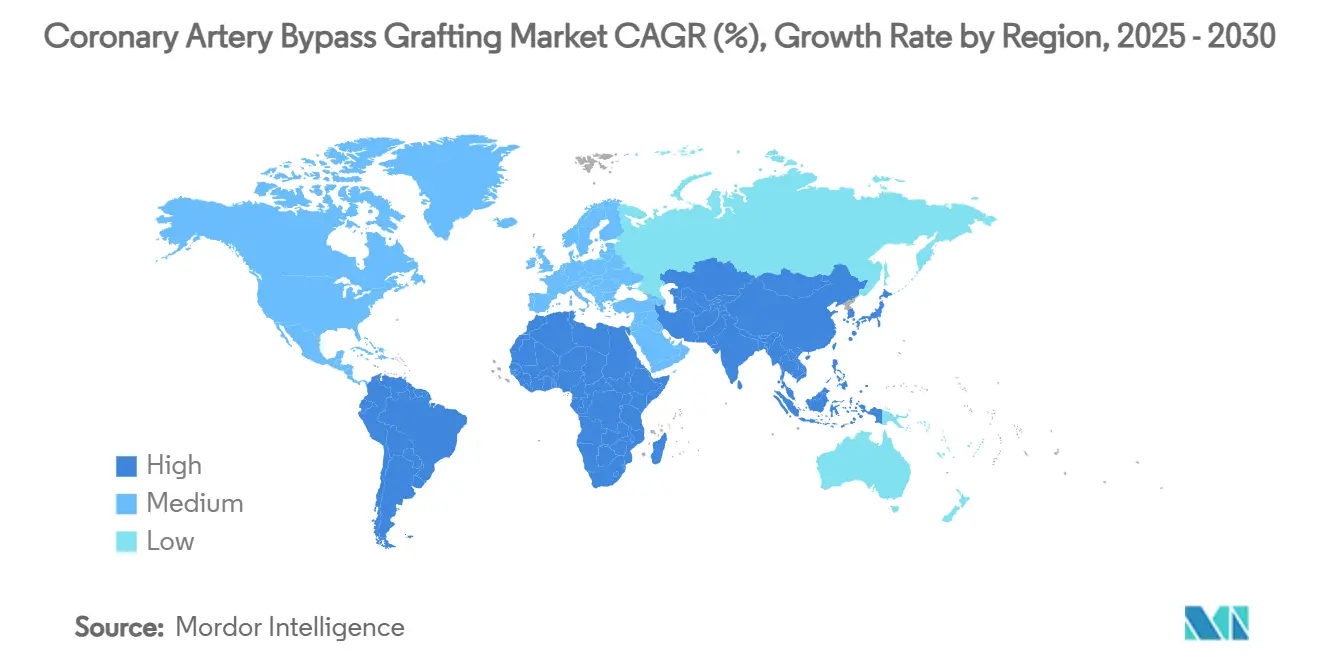
Competitive Landscape
The coronary artery bypass grafting market features moderate consolidation. Medtronic, Edwards Lifesciences, Getinge, and LivaNova anchor the top tier with broad platforms that span heart-lung machines, oxygenators, and perfusion disposables. Strategic acquisitions accelerate portfolio breadth, as Johnson & Johnson spent USD 1.7 billion on V-Wave to deepen structural heart capabilities that complement surgical graft portfolios. Teleflex agreed to purchase BIOTRONIK’s vascular intervention unit for EUR 760 million to reinforce angioplasty-adjacent offerings.
Innovation cycles center on tissue engineering and AI. Humacyte’s acellular vessels secured FDA breakthrough status and aim for CABG trials, potentially redefining conduit sourcing. Edwards Lifesciences presented eight-year durability data for RESILIA tissue showing 99.3% freedom from structural deterioration, strengthening surgeon trust in bio-stable leaflets. Meanwhile, Getinge temporarily lost CE clearance for its Cardiosave system, opening space for compliant rivals in Europe and pushing the group to accelerate remediation.
Competitive differentiation now rests on integrated platforms that pair grafts with imaging, analytics, and service contracts, ensuring procedural consistency and predictable outcomes. Vendors that help providers hit episode-based cost targets without sacrificing quality are poised to grow share inside the coronary artery bypass grafting market.
Coronary Artery Bypass Grafting Industry Leaders
-
Medtronic Plc
-
Getinge AB
-
Genesee Biomedical Inc
-
Terumo Corporation
-
Peter Surgical
- *Disclaimer: Major Players sorted in no particular order
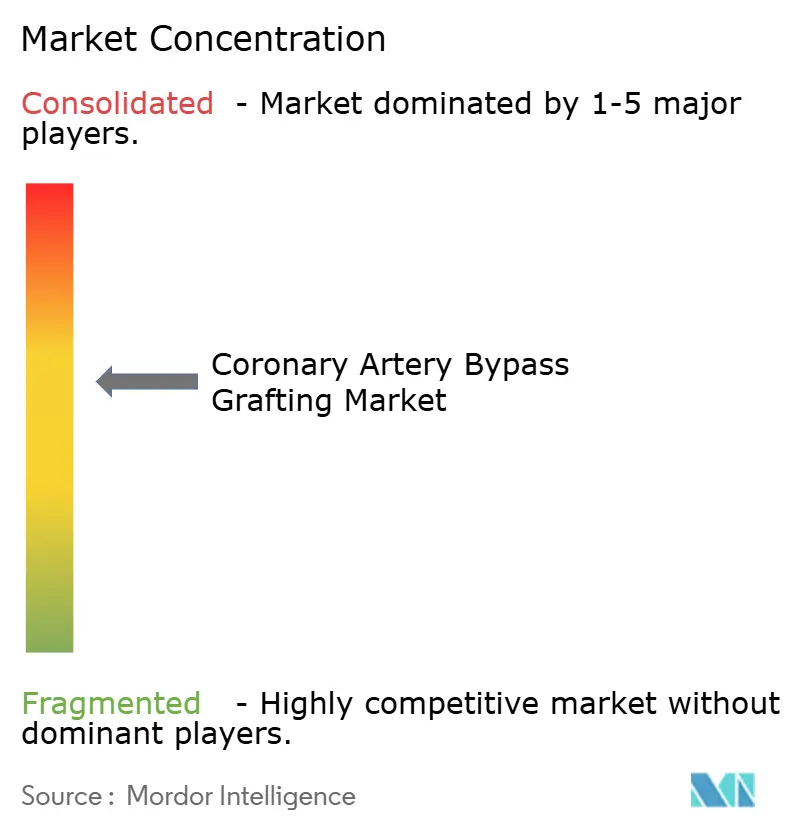
Recent Industry Developments
- April 2025: Edwards Lifesciences announced eight-year data confirming 99.3% freedom from structural valve deterioration for RESILIA tissue.
- April 2025: Teleflex received FDA 510(k) clearance for the AC3 Range intra-aortic balloon pump intended for patient transport.
- February 2025: Teleflex agreed to acquire BIOTRONIK’s vascular intervention business for EUR 760 million, expanding interventional cardiology reach.
- January 2025: Humacyte announced plans to file an IND for small-diameter acellular grafts aimed at CABG patients following strong preclinical results.
Global Coronary Artery Bypass Grafting Market Report Scope
As per the scope of the report, coronary artery bypass grafting (CABG) is a surgical treatment for patients with coronary artery disease (CAD) in which an alternate passage is created for blood to flow to the heart. It is common for three or four coronary arteries to be bypassed during surgery. The Coronary Artery Bypass Grafting Market is Segmented by Technology (Off-pump CABG, On-pump CABG, and Others), Products and Services (Grafts, Retractors, Services, and Others), End Users (Hospitals, Cardiology Clinics, and Other End Users), and Geography (North America, Europe, Asia-Pacific, Middle East and Africa, and South America). The market report also covers the estimated market sizes and trends for 17 different countries across major regions, globally. The report offers the value (in USD million) for the above segments.
| Off-pump CABG |
| On-pump CABG |
| Minimally-invasive/Robot-assisted CABG |
| Hybrid Coronary Revascularisation |
| Conduits & Grafts | Saphenous-vein grafts (SVG) |
| Internal thoracic/ITA grafts | |
| Radial-artery grafts | |
| Synthetic & drug-eluting grafts | |
| Retractors & Stabilisers | |
| Heart–lung Machines | |
| Surgical Instruments & Sutures | |
| Intra-operative Imaging & Navigation | |
| Services (CABG Centres of Excellence) |
| Tertiary-care Hospitals |
| Cardiology / Cardiothoracic Clinics |
| Ambulatory Surgical Centres |
| North America | United States |
| Canada | |
| Mexico | |
| Europe | Germany |
| United Kingdom | |
| France | |
| Italy | |
| Spain | |
| Rest of Europe | |
| Asia-Pacific | China |
| Japan | |
| India | |
| Australia | |
| South Korea | |
| Rest of Asia-Pacific | |
| Middle East and Africa | GCC |
| South Africa | |
| Rest of Middle East and Africa | |
| South America | Brazil |
| Argentina | |
| Rest of South America |
| By Technology | Off-pump CABG | |
| On-pump CABG | ||
| Minimally-invasive/Robot-assisted CABG | ||
| Hybrid Coronary Revascularisation | ||
| By Product & Service | Conduits & Grafts | Saphenous-vein grafts (SVG) |
| Internal thoracic/ITA grafts | ||
| Radial-artery grafts | ||
| Synthetic & drug-eluting grafts | ||
| Retractors & Stabilisers | ||
| Heart–lung Machines | ||
| Surgical Instruments & Sutures | ||
| Intra-operative Imaging & Navigation | ||
| Services (CABG Centres of Excellence) | ||
| By End-user | Tertiary-care Hospitals | |
| Cardiology / Cardiothoracic Clinics | ||
| Ambulatory Surgical Centres | ||
| By Geography | North America | United States |
| Canada | ||
| Mexico | ||
| Europe | Germany | |
| United Kingdom | ||
| France | ||
| Italy | ||
| Spain | ||
| Rest of Europe | ||
| Asia-Pacific | China | |
| Japan | ||
| India | ||
| Australia | ||
| South Korea | ||
| Rest of Asia-Pacific | ||
| Middle East and Africa | GCC | |
| South Africa | ||
| Rest of Middle East and Africa | ||
| South America | Brazil | |
| Argentina | ||
| Rest of South America | ||
Key Questions Answered in the Report
1. What is the current size of the coronary artery bypass grafting market?
The market is valued at USD 14.78 billion in 2025 and is forecast to reach USD 23.04 billion by 2030.
2. Which technology segment is expanding fastest?
Hybrid coronary revascularization is growing at 12.73% CAGR through 2030, driven by minimally invasive robotic techniques that shorten recovery time.
3. Why are ambulatory surgical centers important for future growth?
ASC-based hybrid programs benefit from new Medicare codes and can deliver complete revascularization with shorter stays, supporting an 11.15% CAGR in this end-user segment.
4. How do synthetic grafts impact clinical practice?
Bio-engineered and drug-eluting grafts eliminate harvest site morbidity and show promising patency, helping the product segment post a 13.43% CAGR.
5. Which region will lead growth to 2030?
Asia-Pacific is projected to expand at 12.20% CAGR as healthcare access and specialized training programs scale up advanced cardiac surgery capacity.
Page last updated on:
